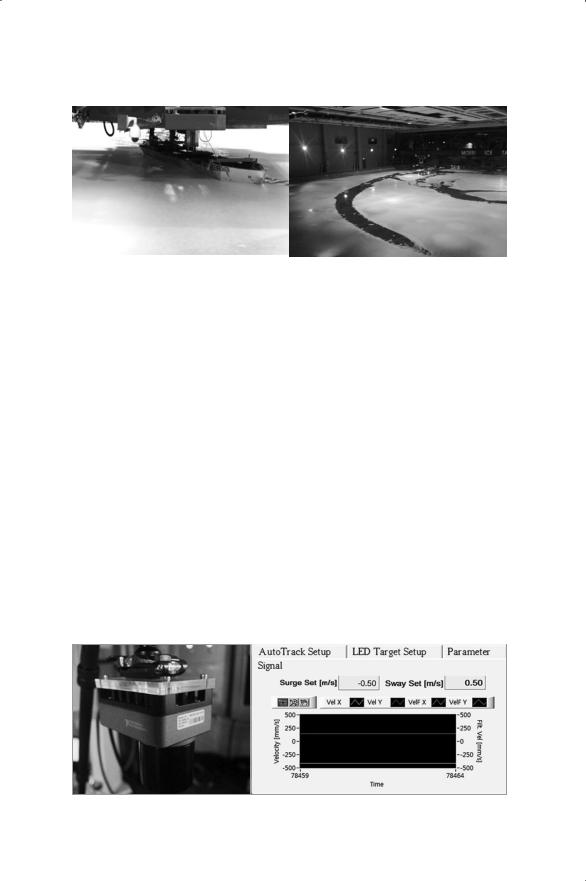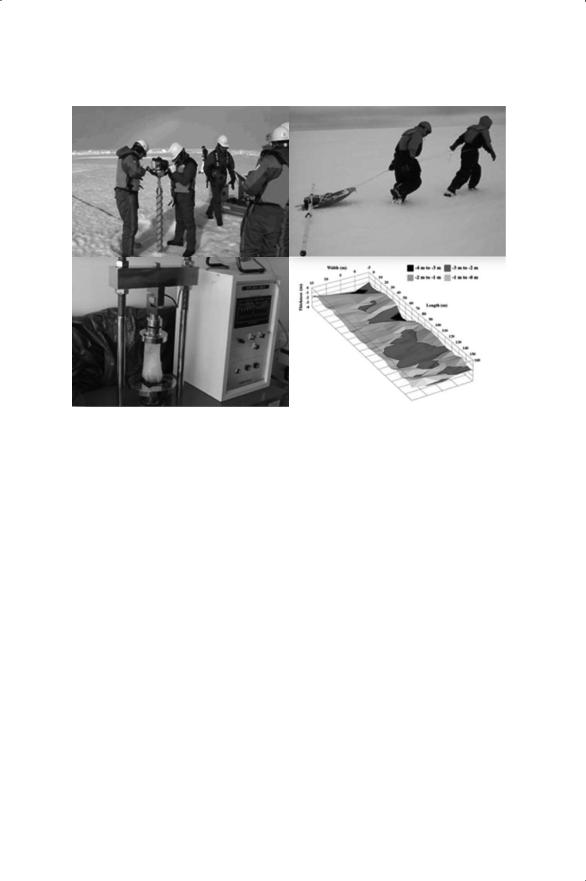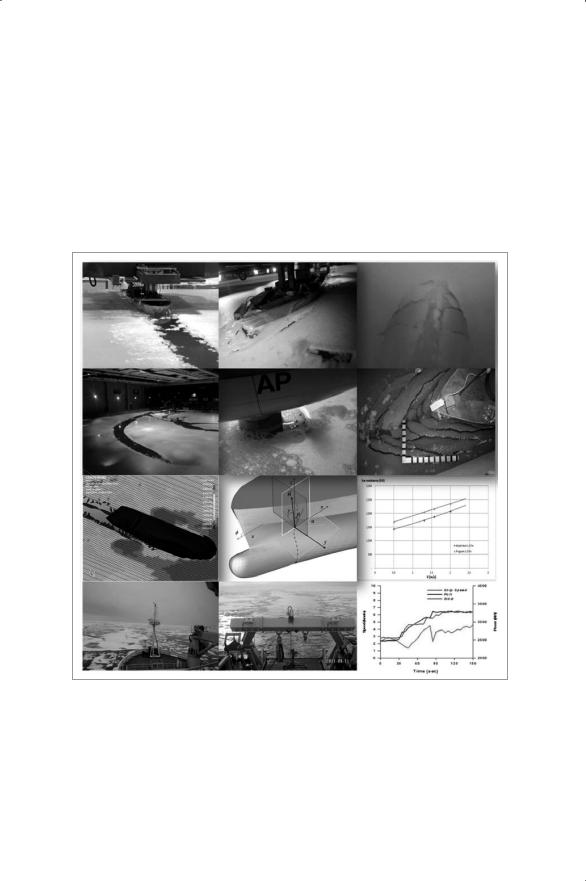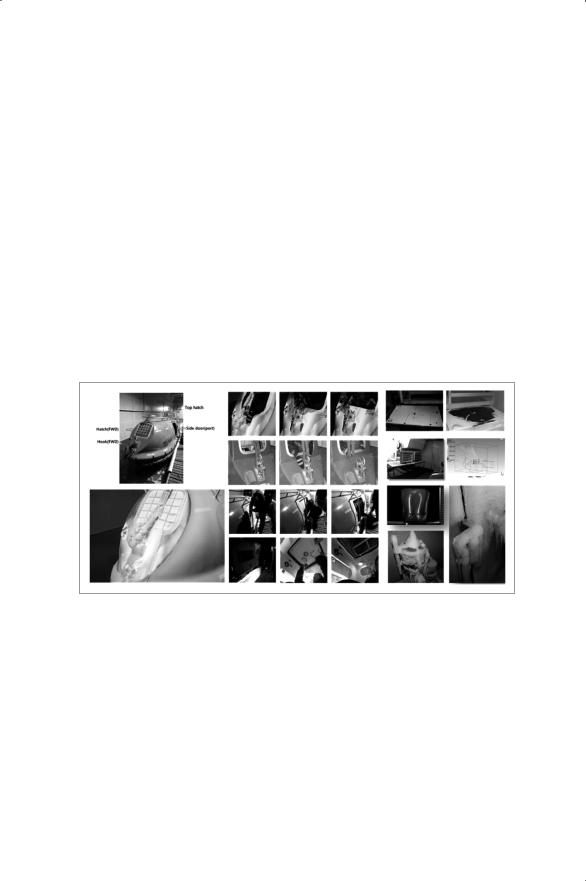
NPAC 2014 Proceedings_final
.pdf
304 |
Innovations Applicable to the Arctic |
|
|
|
|
|
|
|
Figure IV-8. Free-running ice propulsion test and turning circle test using autotracking system
standard procedures will be adopted. Features of the model tests are described below:
•Study the mechanical properties of model ice,
•Resistance, propulsion, and maneuvering tests for icebreaking vessels,
•Prediction of ice load acting on fixed or floating structures,
•Ship/structure and ice interaction analyses.
Recently, an auto-tracking system that can measure the model ship’s location, speed, and heading angle in real-time was developed for the freerunning ice maneuvering test. The system consists of a vision camera and real-time data processing software. The system can define an accurate turning circle diameter and the breaking-out length in a full turning circle test and breaking-out test. In addition, in ice propulsion tests, the model ship’s auto-tracking system can accurately measure the model ship’s speed at a constant propeller revolution, thereby improving the accuracy of the
Figure IV-9. Auto-tracking system and measurement software

Research Activities of the KRISO Ice Tank |
305 |
ice propulsion test.
RESEARCH ACTIVITIES OF KRISO ICE TANK
When a ship navigates ice-covered waters, it encounters various problems, such as ice resistance and ice load. These can affect the performance of the ship and offshore structures in ice. These problems are significant factors in Arctic shipping, in ice-related research areas in Arctic regions, and in Arctic engineering. Since 2010, model tests for ice-going vessels, including ice resistance tests, ice propulsion, and ice maneuvering tests, have been conducted in the KRISO Ice Tank. The results of such tests are important for determining ship performance in ice conditions. Recently, an ice model test for icebreaking vessels, large shuttle tankers, and large LNG carriers operating in ice-covered water was conducted in the KRISCO Ice Tank. In the model test, the ice conditions consisted of level ice, brash ice, pack ice, and ridged ice. The model test in the tank can be used to determine the correlation between model-scale results and full-scale results.
In addition to ice model tests in the tank, full-scale ice performance tests of vessels are important. Such tests are needed to derive the correlation between model-scale and full-scale results and to improve the accuracy of model tests. The aim of an ice trial is to evaluate the ship’s power and performance in various thicknesses and strengths of ice, but field tests are needed along with extensive experience and expertise. In the last two years, ice field tests of the Korean icebreaking research vessel Araon were conducted in the Arctic in July-August 2010 and 2011. These Arctic ice
trials, six in total, were performed |
|
|
|
from 73°N to 78°N. During this |
|
|
|
Ice Floe #4 |
77° 59´ N 159° 37´ W |
||
period, sea ice floes consisted of |
|||
|
|
||
thicker first-year ice, multiyear |
|
|
|
ice, and ridge ice. Ice trials were |
|
|
|
also conducted in the Amundsen |
|
|
|
Sea in February and March of |
|
|
|
2012. During an Antarctic cruise, |
|
|
|
two ice trials were carried out to |
Ice Thickness : 2.55±0.77m |
|
|
evaluate the performance of the |
Ice Freevboard : 0.35±0.77m |
|
|
Snow Depth : 0.10±0.01m |
|
||
research vessel Araon on big floes. |
|
|
|
Figure IV-10. Full-scale ice trial of Korean |
|||
In the ice trials, in addition to ice |
|||
icebreaker Araon |
|
||

306 |
Innovations Applicable to the Arctic |
|
|
|
|
|
|
|
|
|
|
Figure IV-11. Ice thickness and strength measurement on old ice floe
properties, the time, location, engine power, revolutions per minute during the trial, and trajectory of the ship were recorded.
In ice trials, sea ice information is divided into concentration, thickness, and strength, and this information is used to evaluate the icebreaking performance of the ship. In the ice trials of an ice navigator from the Arctic and Antarctic Research Institute, the sea ice concentration at the ship’s bridge and in the ice floe field was measured. Ice detection radar and a helicopter were used to define the size and condition of the sea ice. The thickness of the sea ice was measured by ice drilling. The ship’s speed and main engine power were also recorded during this period. Using these data, we evaluated the ship’s icebreaking performance.
As mentioned earlier, the sea ice thickness was measured by ice drilling in the field. Ice freeboard and snow depth were measured with an ice thickness gauge at intervals of 10m or 20m in selected test ice floes and a measuring stick. Figure IV-11 shows an intended ship track on a selected ice floe and ice drilling and coring with an ice auger and ice-coring device. During field measurements, sea ice thickness, temperature, weight, density, salinity, and crystal structures were measured by ice drilling. The compressive strength of the ice was measured with a universal test machine,

Research Activities of the KRISO Ice Tank |
307 |
and the flexural strength of ice was calculated using salinity, temperature, and density results. The ship speed and power of the main engine plant were also measured in onboard tests on the ship. The performance of the ship in ice can be determined based on the measured engine power and ship speed for time history.
Until recently, the KRISO Ice Tank conducted only national research projects for Arctic research. This project focused on the development of safe operation methodology for ice-class vessels operating in Arctic sea routes and cryogenic evaluation techniques for determining a ship’s ice performance. The project was carried out with the participation of universities, ship registers, shipbuilders, and marine research institutes. The strategic objectives addressed during the project were as follows, shown in order of priority:
1.Develop safety assessment techniques for the hull structure of icebreaking vessels to assess the design loads on a ship’s hull,
2.Develop ice model test methodology to evaluate the ship’s performance in ice and improve model test results,
3.Develop anti/de-icing techniques for ship machinery to secure its operating performance in low-temperature conditions to get the required ice class.
The aim of the project was to perform fundamental research for icegoing vessels based on ice-class rules. The main purposes were to develop a model test technique and analysis method, to determine the ice resistance of and ice loads on a ship’s hull, to define the correlation between modelscale and full-scale results, to assess the hull’s strength during ship-ice interactions, and to develop a numerical simulation technique for ship-ice collision. The outline and research extent is summarized below:
Project title: Development of Safe Operation Methodology for an IceClass Vessel Operating in Arctic Sea Routes and Cryogenic Evaluation Techniques for Determining its Performance in Ice
Total project period: 2009.06–2014.05
Total project funding: 2 million USD/year, Ministry of Knowledge and Economy, Korea
• Part 1. Safety Assessment Techniques for Hull Structure of Icebreaking

308 |
Innovations Applicable to the Arctic |
Vessels (Organization: Korea Maritime and Ocean University),
•Part 2. Development of Ice Test and Ice Performance Optimization Methodologies (Organization: Korea Research Institute of Ships and Ocean Engineering),
•Part 3. Arctic Design Technology and Winterization Performance Evaluation (Organization: Korea Research Institute of Ships and Ocean Engineering).
This research project resulted in the development of various new technologies and applications, as described below:
1.Development of accurate ice model test methodology and optimization of the performance of ice-going vessels in ice conditions.
2.Evaluation of the winterization performance of marine equipment of ice-going vessels.
Part 1. Safety Assessment Techniques for Hull Structure of Icebreaking Vessels
Project outline
1.Research objective: Development of safety assessment techniques and analysis procedure of icebreaking vessels,
2.Participating institutions: universities, ship registers, shipbuilders, and research institutes.
Research results
•Estimation and analysis of full-scale ice load acting on a ship’s hull
a.Ice modeling technique for theoretical ice load estimation
b.Numerical modeling method for ship and ice interaction
c.Full-scale ice load measurement procedure and analysis method,
•Impact response of ice collision and safety assessment of ship hull
a.Ship and ice collision analysis using LS-DYNA
b.Ice load estimation based on various ship and ice collision scenarios
c.Safety assessment of Mark III membrane CCS.
Applications
• Estimation of ice load on large icebreaking vessels,

Research Activities of the KRISO Ice Tank |
309 |
|
|
|
|
•Safety assessment of icebreaking vessels and ice-load prediction design.
Part 2. Development of Ice Test and Ice Performance Methodology
Project outline
1.Research objective: Development of model test and ice performance analysis methods,
2.Participating institutions: Research institute and universities.
Research results
•Model test and analysis of icebreaking vessels:
a.Uniform model ice-generation methodology
b.Ice model test in various ice conditions (level ice, brash ice, ridged ice, etc.) with standard ice model test procedure
c.Numerical simulation of ship and ice interaction
d.Propeller and ice interaction analysis
e.Ice resistance and delivered power prediction of icebreaking vessels

310 |
Innovations Applicable to the Arctic |
f. Full-scale ice trial test procedure.
Applications
•Delivered power and resistance prediction of large icebreaking vessels,
•Numerical simulation and analysis methods using commercial code,
•Technical services to shipbuilding company to improve the ice performance of icebreaking vessels.
Part 3. Arctic Design Technology and Winterization Performance
Evaluation
Project outline
1.Research objective: Development of shipboard winterization techniques,

Research Activities of the KRISO Ice Tank |
311 |
2.Participating institutions: Research institutes, universities, ship registers, shipbuilders.
Research results
•Winterization techniques for Arctic vessels based on ice-class rules:
a.Standard winterization performance test procedure in cold room
b.Anti/de-icing techniques for ship machinery (P/V valves, walkways, handrails, and louvers, etc.)
c.Heat transfer analysis of ship equipment.
Applications
•Winterization performance evaluation of ship equipment at low temperature,
•Shipboard winterization techniques for ice-class vessels.
FUTURE PLANS FOR KRISO ICE TANK
The KRISO Ice Tank will provide the research community and industries with reliable access to an ice-modeling facility and expertise for their R&D activities on ice-going vessels and novel structures, advanced transportation systems and technology, and operational concepts for services in ice-covered water. Initial research activities will be devoted to adapting and fine-tuning various ice-testing techniques by performing a variety of tests on icebreaking ships and on fixed and floating structures under various ice conditions.

312 |
Innovations Applicable to the Arctic |
Future work:
•Ice model test for a second Korean icebreaker and ice-performance evaluation,
•Development of safe operation technology in Arctic sea routes,
•Ice-structure interaction analysis and development of model test methodology for various offshore structures operating in Arctic regions,
•Development of cooperative relationship and partnership between members of the KRISO Ice Tank facility and others.
DISCUSSION: WHAT NEW TECHNOLOGIES IN THE AREAS OF FUTURE ARCTIC MARINE SHIPPING AND ASSOCIATED R&D ARE ON THE HORIZON THAT WILL IMPACT THE FUTURE OF THE ARCTIC?
Floating structures, such as large-size semi-submergible, drill-ship and LNG-Floating Production Storage and Offloading (FPSO), are believed to be feasible for marine operation in ice-covered waters. Many types of ice features, including level ice, ice ridge, pack ice and rubble ice, will pose potential challenges with respect to concept design and operations. The discussion takes into account what critical technology for floating structures operating in Arctic regions will be needed. The aim of this discussion is to contribute knowledge about ice actions on floating structures, how they can be estimated, as well as the dynamic response from model tests in ice. The specifications of the critical technology of floating structures are given for operations in ice-covered waters. This effort focuses on the requirements that should be met when the floating structures go to operate in the Arctic. The intention of this discussion will be to contribute increased knowledge about the interaction between floating structures and ice by conducting model tests in ice and by developing methodology for numerical studies. First, the fundamental studies of ice-structure interaction and ice failure mode will be discussed. Ice model tests to estimate the resistance in ice, mooring force and ice load will be conducted in the ice tank facility. Then, design concepts based on ice class rules will be provided. The intended research areas of this discussion are summarized as follows:

|
Research Activities of the KRISO Ice Tank |
313 |
|
Table IV-1. New Arctic technology research |
|
||
|
|
|
|
Technology |
Research |
Critical technology elements |
|
group |
theme |
|
|
|
|
|
|
Fundamental |
Ice-structure |
Ice-Structure Interaction Scenarios and Failure Mode |
|
research |
interaction analysis |
of Ice |
|
|
|
Probability Distribution and Extreme Value Analysis of |
|
|
|
Local Ice Pressures |
|
|
|
Prediction of Design Ice Load of Floating Structure |
|
|
|
Estimation of Ice Impact Force Acting on Floating |
|
|
|
Structures Based on Impact Mechanics |
|
Advanced |
Model test for |
Modeling Techniques of Arctic Sea Ice Conditions in |
|
research |
ice-structure interaction |
Ice Tank (Rubble ice, Ridged ice, etc.) |
|
|
|
Development of Model Test Methodology for |
|
|
|
Structural Shape (GBS, Floating, etc.) |
|
|
|
Development of Model Test Methodology for Various |
|
|
|
Floating Structures |
|
|
|
Comparison of Model Test Results Between Other Ice |
|
|
|
Tank Facilities |
|
|
Analytical and |
Ice-Structure Interaction Analysis Based on Analytical |
|
|
numerical and analysis |
Method (Empirical method, Energy consideration, etc.) |
|
Ice-Structure Interaction Analysis Based on Numerical Method (Ice fracture simulation, Structural analysis, etc.)
APPENDIX: FULL-SCALE ICE TRIAL PROCEDURE
An analysis of ship performance in ice is important at the ship design stage. Such analysis is normally executed using a computer program based on accumulated experimental data and a ship model test in an ice tank. After construction, sea trial tests are usually used to evaluate the power performance of ships. The results of sea trial tests provide valuable technical data to investigate the correlation between predicted results and trial test results. The technical data accumulated in the tests can be used to predict the power performance of another ship and to develop new hull forms for ships. It is difficult and expensive to conduct field trials of icebreaking vessels because it is not easy to navigate the sea ice field. The correction method of sea ice field test results is requested to develop. The speed of icebreaking vessels is related not only to the propulsion power
